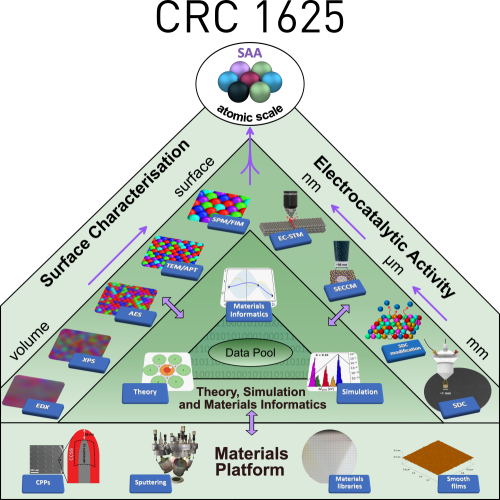The CRC is organised in three research areas. The scientific projects in the research areas are complemented by the projects INF (research data management), providing the data science infrastructure, S, providing global surface characterisation, RTG as the core training unit for the highly interdisciplinary research, and Z, which will coordinate and manage the CRC. The research areas and projects are interlinked by cross-project collaboration topics.

Two projects (A01-Ludwig, A02) will synthesise the thin films for the CRC, three projects are working on theory and simulation of SAA and CCSS (A01-Rossmeisl, A03, A04), and two projects on materials informatics (A05, A06). The projects A01-Ludwig and A02 are the synthesis projects of the CRC and provide its consistent materials platform, which has the advantage to provide perfect sample and data lineage tracking as well as ideal comparability of all materials, as all films are from one source. Synthesis will be guided by both data from theoretical predictions and results of high-throughput and atomic-scale characterisation. A01-Rossmeisl will simulate the activity for the different CCSS systems, while A03 will calculate phase stability and ordering/segregation phenomena. A04 will complement the studies by DFT calculation of the interaction of an aqueous solution with the CCSS surface.
Five projects apply and develop atomic-scale resolution characterisation tools, i.e., APT (B01, B02), (S)TEM (B03), FIM (B04), and STM (B05), to investigate the CCSS surface structure and composition with the aim to be able to describe the SAA, both structurally and chemically. B01, B03, and B05 focus on as-deposited and annealed states of SAA while B02 and B04 perform also experiments under reactive conditions. B01 employs APT and coated microtip arrays as a screening method for phase stability, surface and grain boundary segregation whereas B02 uses APT to correlate composition and electrocatalytic properties on selected CCSS. While the APT measurements provide the three-dimensional chemical composition of the CCSS with highest sensitivity, (S)TEM (B03), FIM (B04), and STM (B05) provide the information on atomic distance in cross-section, 3D or top-view, respectively. A methodology joining the different techniques will be developed to get full access to the SAA.
The hydrogen evolution reaction (HER) will be used as a probe reaction to measure the modulation in activity of SAA from the CCSS. While the averaged electrochemical activities of different CCSS will be measured in C01 using SDC, in C02 a zooming-in approach will be explored by SECCM to probe statistical distributions of SAA while in C04 active sites are to be measured using EC-STM. In C03 dealloying and underpotential deposition of CCSS will be used as tools to induce changes in SAA. In a joint research effort, a scale-bridging methodology will be established which will allow to do electrochemical probing from large scale down to individual SAA.